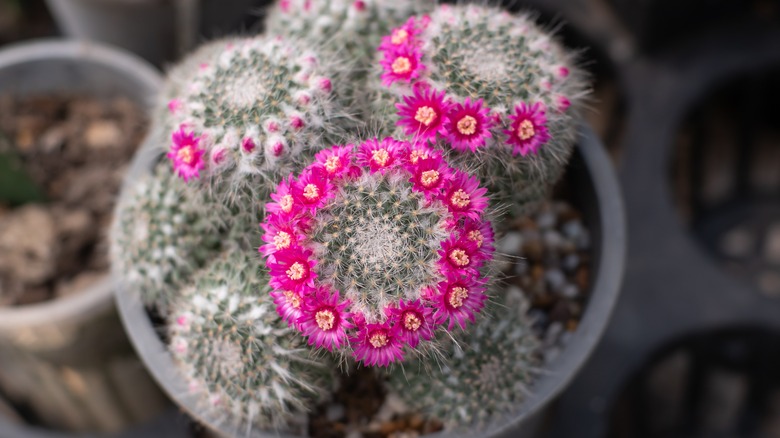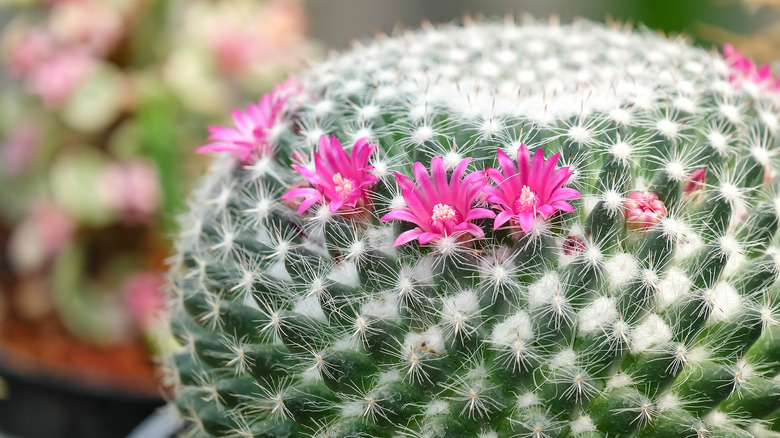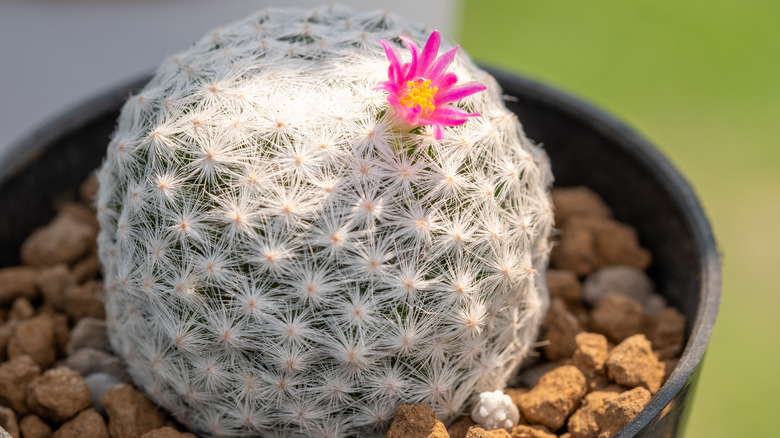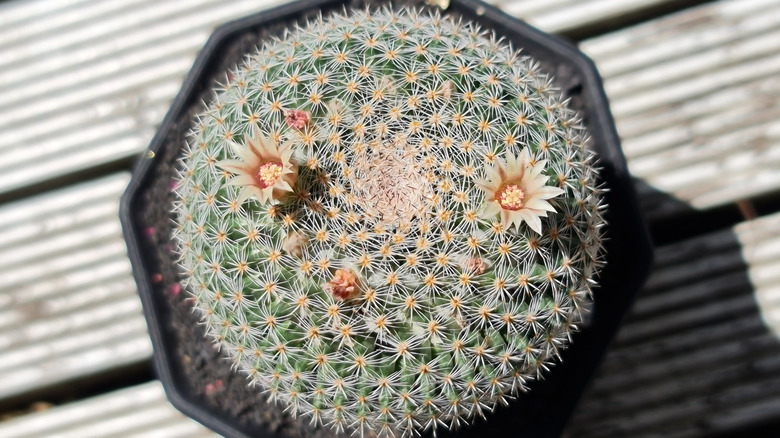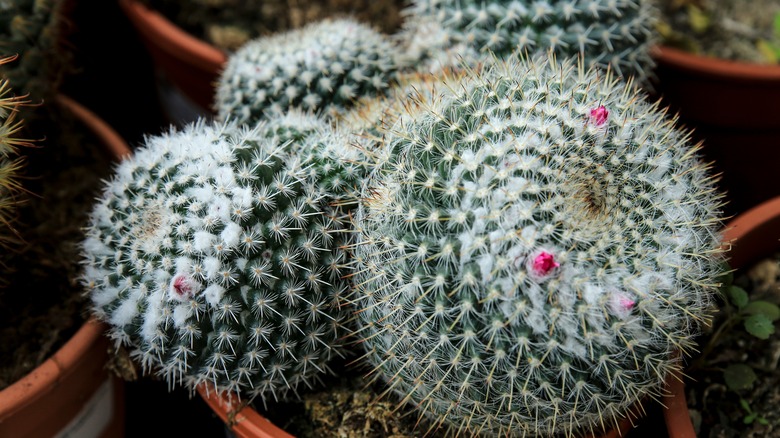How To Care For An Old Lady Cactus
The old lady cactus, scientifically named mammillaria hahniana, is a flowering species of cactus in the cactaceae family. The plant is native to the warm, sunny climate of Central Mexico, as per World of Succulents. Outside of this climate, the old lady cactus is most often grown indoors, where the temperature and humidity can be controlled.
According to Houmse, the cactus's scientific name is derived from the Latin word for "nipple." Nipple refers to this plant's prominent tubercles or lumps. The old lady cactus features one or more bulbous stems covered with fine, spiky hairs. The cactus can reach 10 inches high and 20 inches wide in adulthood. If you take good care of this plant, it will also produce beautiful pink-purple flowers that often form a complete halo at the apex of the stem. It isn't difficult to achieve this level of care. With regular watering, a sunny spot, and the right kind of soil, you too can grow these unique flowering cacti.
How to grow an old lady cactus
To grow an old lady cactus, you'll need gardening gloves, a self-draining pot, and a succulent or cactus potting mix supplemented with coarse sand or perlite for drainage. Once you have collected these supplies, you are ready to grow. The most common way to grow your own old lady cactus is propagation through offsets. While it is possible to grow one from other methods of propagation such as division and grafting, offsets produce the most reliable results.
Before you begin the process of propagating an old lady cactus with offsets, first, allow the soil beneath your mature plant to dry completely, as per Garden Beast. Then, while you are wearing gloves, remove the offsets which form at the base of the cactus. These look like tiny versions of the parent plant. Next, place the offsets on a towel to dry out for several days. Watch the cut side of the offset for a callous. Once calloused, you may move on to the next step.
Dip the bottom of your offset into a rooting hormone to help it develop roots faster. Then, fill a small pot with your cactus potting mix. Place your offset in the pot, and push it down gently to secure it in the soil. Place the container and offset in a warm spot of your home with some indirect sunlight. According to Succulent City, after watering it weekly for about a month, the offset should develop its own root system.
How to care for an old lady cactus
Old lady cacti are no-stress plants. If you tend to forget about your succulents, this one's for you. As long as you keep it in a warm spot, you are unlikely to kill it. The most important thing they require is regular, direct sunlight and warm temperatures. Succulent Plant Care says you can either place your cactus outside in a sunny spot during the summer or keep it in a bright area of your home as a houseplant. If you can't keep your plant warm enough next to your windows, consider investing in a grow light.
Try to give this cactus water on an infrequent basis. The easiest way to tell if your old lady cactus is thirsty is to check its soil. If it appears to be dry all the way through, it needs water. Plan to check this plant's soil two to four times per month, and even less in the winter. Unsurprisingly, the old lady cactus doesn't require fertilizer either. Though, it won't argue with you if you give it diluted cactus feed during its growing season, explains Gardening Know How.
Old lady cactus varieties
There are more than 200 species in the mammillaria genus, according to Garden Beast. Nearly all of these species are native to Mexico, and just as many are cultivated for ornamental use. Some of the most popular mammillaria species per The American Southwest include mammillaria tetrancistra "fishhook cactus," mammillaria dioica "strawberry cactus," and mammillaria pottsii "fox-tail cactus." Even though our old lady cactus, mammillaria hahniana, has so many unique siblings, it is just as one-of-a-kind as all its varieties as follows.
-
Mammillaria hahniana var. verderm: Almost identical to the common old lady cactus, this variety features darker violet-red flowers that form a ring near the stem's apex.
-
Mammillaria hahniana var. albiflora: Features the same stem height and diameter, with the difference of white petaled flowers instead of pink.
-
Mammillaria hahniana var. bravoae: This is the most like our familiar old lady cactus, yet it is characterized by deep pink blooms crowning the head of this variety.
How to repot an old lady cactus
If you are familiar with repotting succulents and cacti, repotting your old lady cactus will be a breeze. Make sure before repotting you have gathered gardening gloves, succulent and cacti potting mix, coarse sand or perlite to use as an additive, and a slightly larger self-draining pot.
To begin the repotting process, first ensure that the soil under your cactus is bone-dry. Wet soil can make repotting more difficult and increase the chances of sending your plant into shock, as explained by Succulent Plant Care. Once the soil is dry, you can gently remove your old lady cactus from its pot. This step can be tricky. You may need to run a flat tool along where the pot meets the soil to help dislodge the plant. With the base of the cactus in your fingers, knock the excess dirt from the roots. When most of the roots have been revealed, you can plant your cactus into its new pot. With fresh soil, cover the exposed roots and pack your friend into its new container to secure it. Succulent Plant Care advises waiting to water the plant for a few days to allow it to settle in its home.
